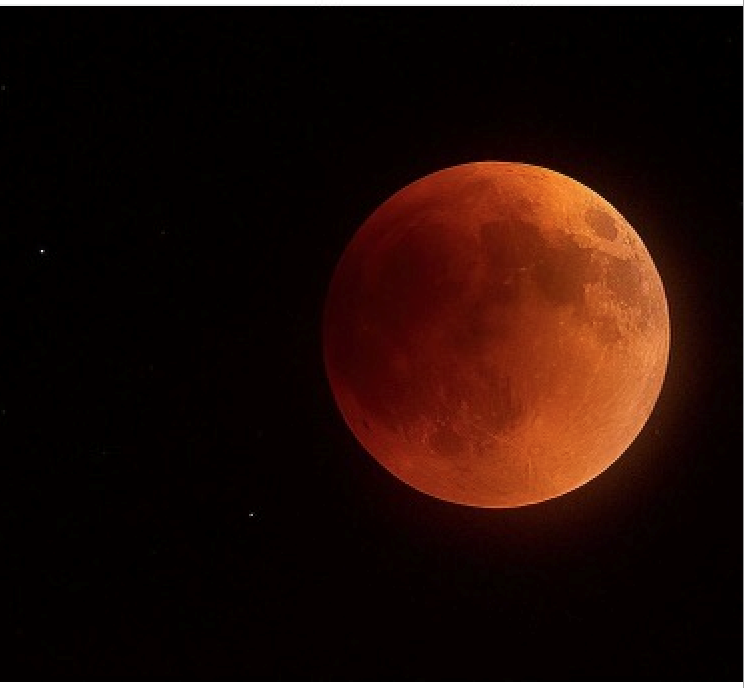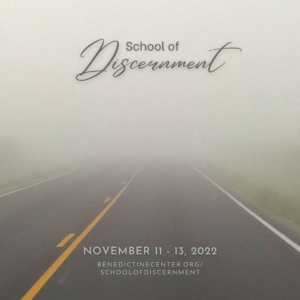Still Life With Moon
Mary Elizabeth Ilg, Co-Director, Benedictine Center

On Sunday, May 15, everything seemed to change; there was some kind of transformational shift. After six months of winter, it was finally spring in Minnesota with green buds on the trees, blue sky, and a cavalcade of tulips. I went for an afternoon drive to enjoy the rolling expanse of countryside and wide open fields—so much freedom. Driving north on Manning Avenue, a white SUV going 70 mph headed straight toward me in the oncoming lane, passing a tractor. I hit the horn; the vehicle returned to its own lane, just in time.
Unfazed, I continued on my way. As I approached the quaint town of Afton, driving down a leafy narrow road, a black cat suddenly emerged from the trees. Will it cross my path? The cat surveyed me momentarily, then turned and disappeared into the woods.
I drove past the beach, where I have gone with my family for decades to swim and enjoy the languorous days of summer. The river is high right now; the sand is slowly disappearing. A few teenagers were there, sitting on towels and laughing. The sky was brilliant over the water, heartbreakingly blue with a few billowing white clouds. I looked forward to returning there for more happy days in June.
At home later that evening, I walked through my own neighborhood. The crab apple trees beginning to blossom filled the air with sweet perfume. I headed to the park to see the moon coming up over the treetops and suburban roofline to witness the beginning of the lunar eclipse.
The air was cool and fresh. I saw no one. This was odd: to see no people whatsoever. The streets were empty at nine o’clock; the houses and people inside them were silent. This was in stark contrast to earlier that day when many were outside with their leaf blowers and lawn mowers, creating a constant racket. A neighbor across the street from me walks around his yard for an hour each week wearing his leaf blower strapped to back, aiming the long noisy hose at a single leaf on his perfectly mowed emerald green lawn. I used to actually cry when he came out of his house with that machine. I marveled at the progress I’ve made through the practice of centering prayer meditation (with some help from AirPods Max) and no longer become so distressed by the neighbors’ noise.
The moon was rising slowly like a gold balloon, but I could not quite see it. It was still hidden by trees. The cool breeze was delicious. I stood alone on the empty sidewalk and waited patiently as it made its slow ascent. The moon sent down its healing balm and radiance. Two hours later, the same moon turned blood red in the sky and Earth created a dark shadow over it. This is when things got really wonky. I was standing at the end of my driveway by then, at 11:11 p.m., the hour of supernatural phenomena. All of the neighbors up and down my street were in bed. Everyone in my house was asleep, and I felt like the only person left at the end of the world. I watched the round shadow spin over the red ball of the moon in pure silence. A different kind of energy seemed to permeate the atmosphere, a kind of hum across the suburban lawns: I felt strangely powerful, wide awake, ready to take on anything. Perhaps that feeling is why the Ancients called moments like this a sign.
Another moment of great significance, for many of us a sign: on May 10, the St. Enda 100-Day Retreat concluded, conducted through voice memos sent by email to the Oblates of St. Paul’s Monastery and others by Professor Kathleen Cahalan of St. John’s University in St. Joseph, MN and Sister Meg Funk, OSB from Our Lady of Grace Monastery in Beech Grove, IN. This was a beautiful time of instruction for us, where we also learned valuable tools including the practice of letting go of afflictive thoughts. We are not our thoughts, and we can make the conscious decision to stop our negative thinking and emotions from taking over. One tool is the short arrow prayer, a line from a favorite psalm: “The Lord is my light and my salvation.” Short arrow prayers can be repeated silently as needed, in any circumstance. We can let God change a bad day into a good day.
“Knowing Jesus has been the greatest joy of my life,” Sister Meg Funk said softly in her voice memo to us on April 7. He comes to us personally, distinctly, if we give our consent and ask him to be present to us. People come and go in our lives; even our precious children grow up and move away, but God is constant. “Jesus has done the heavy lifting for us,” Sister Meg said on May 10, the final day of the retreat. Because of the death and resurrection of Jesus Christ, we can surrender all of our difficulties to him, all of our worries, struggles, illnesses, fears, anxieties, relationships, even war and a global pandemic and trust that Jesus will make all things right according to his will. “Thy will, not mine, be done.” Through the process of discernment, sustained lectio divina of sacred Scripture, centering prayer and other spiritual practices, we can come to know God’s will for our lives. This peace which passes all understanding and deep serenity can be achieved when we cooperate with God’s will and carry out that which we believe we are called to do.
The St. Enda retreat provided riches of wisdom too great to be recounted here. The retreat will be held again this fall, and those who are interested can contact the Benedictine Center to be added to the mailing list: info@benedictinecenter.org.

In addition, we are pleased to announce that Kathleen Cahalan will again lead the School of Discernment November 11-13, 2022. Find more information and register here: www.benedictinecenter.org/events/2027/.
Come and see us soon at the Benedictine Center! We are open every day for personal and scheduled group retreats.
May God bless you and keep you until then.

